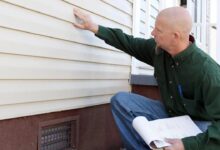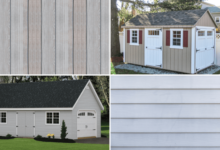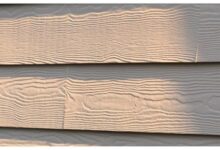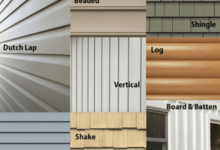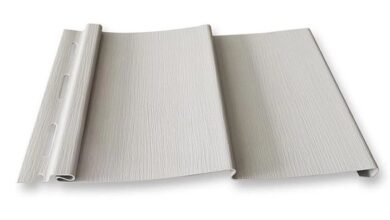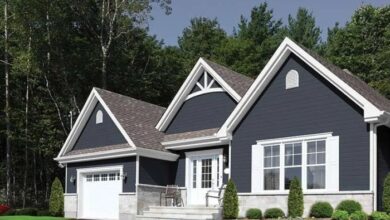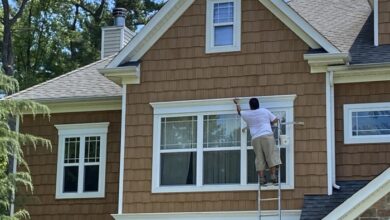Sustainable Siding Materials A Green Building Guide
Sustainable Siding Materials are transforming the construction landscape. This isn’t just about aesthetics; it’s about minimizing environmental impact throughout a material’s entire lifecycle, from sourcing raw materials to disposal. We’ll delve into the diverse options available, examining their performance, cost-effectiveness, and aesthetic appeal, helping you make informed decisions for your next project.
Choosing sustainable siding means considering more than just initial cost. Factors like durability, maintenance needs, energy efficiency, and the overall environmental footprint of the material play crucial roles. This guide will provide a comprehensive overview, equipping you with the knowledge to select the best sustainable siding for your specific needs and budget, contributing to a greener future, one house at a time.
Defining Sustainable Siding Materials
Choosing sustainable siding isn’t just about aesthetics; it’s a commitment to environmental responsibility. This involves considering the entire lifecycle of the material, from its sourcing and manufacturing to its eventual disposal or repurposing. Making informed choices about your home’s exterior can significantly reduce your carbon footprint and contribute to a healthier planet.Sustainable siding materials meet specific criteria encompassing environmental impact, resource depletion, and overall lifecycle performance.
A truly sustainable option minimizes its environmental footprint throughout its entire lifespan, from raw material extraction to end-of-life management. This holistic approach is key to responsible building practices.
Criteria for Classifying Sustainable Siding
The classification of siding as “sustainable” depends on several key factors. These factors are interconnected and should be assessed holistically rather than in isolation. A material’s sustainability is not determined by a single characteristic but by a combination of its attributes across its life cycle. For instance, a material might be made from recycled content but have a high embodied energy, thereby impacting its overall sustainability rating.
- Embodied Carbon: This refers to the greenhouse gas emissions associated with the entire life cycle of the material, from raw material extraction to manufacturing, transportation, installation, and disposal. Lower embodied carbon is a crucial indicator of sustainability.
- Recycled Content: Siding made from recycled materials reduces reliance on virgin resources and minimizes waste. The percentage of recycled content should be clearly specified.
- Renewable Resources: Using materials from renewable sources, such as rapidly growing bamboo or sustainably harvested wood, reduces the depletion of finite resources.
- Durability and Longevity: A durable siding material requires less frequent replacement, reducing the overall environmental impact over its lifespan. This minimizes the need for future resource extraction and manufacturing.
- Manufacturing Process: The manufacturing process itself should be energy-efficient and minimize pollution. Look for materials produced with clean energy sources or employing sustainable manufacturing techniques.
- End-of-Life Management: Consider how easily the siding can be recycled, reused, or composted at the end of its life. Materials that can be easily recycled or repurposed have a lower environmental impact.
Examples of Sustainable Siding Materials
Several materials are commonly considered sustainable siding options. The choice depends on specific project needs and regional availability. Each material presents its own unique set of advantages and disadvantages regarding sustainability.
- Recycled Plastic Lumber: Made from recycled plastic, this material offers excellent durability and weather resistance. Its production diverts plastic waste from landfills. However, the energy intensity of the manufacturing process needs to be considered.
- Fiber Cement: A composite material made from cement, cellulose fibers, and other additives, fiber cement is durable, fire-resistant, and requires minimal maintenance. While its embodied carbon is relatively low compared to some other options, the manufacturing process still has an environmental impact.
- Bamboo: A rapidly renewable resource, bamboo siding is a sustainable and aesthetically pleasing option. However, its susceptibility to moisture and insects requires proper treatment and maintenance.
- Sustainably Harvested Wood: Wood siding from sustainably managed forests offers a renewable and aesthetically pleasing option. Certification from organizations like the Forest Stewardship Council (FSC) ensures responsible forestry practices.
Environmental Impact Considerations
The environmental impact of different siding materials varies significantly. Comparing their lifecycle assessments provides a comprehensive understanding of their sustainability. Factors such as embodied carbon, water usage, and energy consumption during manufacturing and transportation all contribute to the overall environmental impact.
| Material | Embodied Carbon (kg CO2e/m²) | Recycled Content (%) | Renewable Resource? |
|---|---|---|---|
| Recycled Plastic Lumber | Variable, depends on manufacturing process | High (often >90%) | No |
| Fiber Cement | Relatively low compared to some other options | Variable, typically lower than plastic lumber | No |
| Bamboo | Relatively low | 0% (typically) | Yes |
| Sustainably Harvested Wood | Variable, depends on species and management practices | 0% (typically) | Yes |
Note: The data in this table is illustrative and can vary depending on specific manufacturing processes, material composition, and transportation distances. Consult lifecycle assessment reports for specific product information.
Lifecycle Assessments of Sustainable Siding Materials
A lifecycle assessment (LCA) is a standardized methodology for evaluating the environmental impacts of a product throughout its entire life cycle. LCAs consider factors such as raw material acquisition, manufacturing, transportation, use, and end-of-life disposal. Comparing LCAs of different siding materials allows for a more informed decision-making process. For example, a material with a low embodied carbon might still have a high environmental impact due to high energy consumption during manufacturing or a lack of end-of-life recyclability.
Detailed LCA studies are crucial for a complete picture of a material’s environmental footprint.
Material Properties and Performance
Choosing sustainable siding isn’t just about environmental responsibility; it’s about making a smart, long-term investment in your home. The performance characteristics of your siding directly impact its lifespan, maintenance needs, and even your energy bills. Understanding these properties is crucial for making an informed decision.
Sustainable siding materials offer a diverse range of properties, each with its own strengths and weaknesses. Factors like durability, thermal performance, and resistance to weather damage significantly influence a material’s suitability for a particular climate and building style. This section delves into a detailed comparison of these key performance aspects across several popular sustainable options.
Durability, Maintenance, and Lifespan of Sustainable Siding Materials
The longevity and ease of maintenance of your siding are critical factors affecting both cost and aesthetic appeal over time. A longer lifespan reduces the need for frequent replacements, contributing to overall sustainability. Conversely, high-maintenance materials demand more time, effort, and potentially resources for upkeep.
| Material | Durability | Maintenance Requirements | Lifespan (Years) |
|---|---|---|---|
| Reclaimed Wood | High (with proper treatment) | Moderate (periodic staining/sealing) | 50+ |
| Fiber Cement | Very High | Low (occasional cleaning) | 50+ |
| HardiePlank | High | Low | 30-50 |
| Bamboo | Moderate (depends on treatment) | Moderate (periodic sealing/treatment) | 20-30 |
Thermal Performance and Energy Efficiency
Sustainable siding materials often contribute significantly to a building’s energy efficiency. Their ability to insulate and regulate internal temperatures directly impacts heating and cooling costs. Materials with superior thermal performance reduce energy consumption, lowering carbon footprint and saving homeowners money in the long run.
For example, fiber cement siding, due to its density, offers excellent insulation properties, reducing heat transfer and minimizing the strain on your HVAC system. Conversely, materials like reclaimed wood, while aesthetically pleasing, may require additional insulation measures to achieve optimal energy efficiency depending on the thickness and wood type.
Resistance to Weather Damage
The ability of siding to withstand harsh weather conditions is paramount to its longevity and overall performance. Exposure to moisture, UV radiation, and extreme temperatures can lead to degradation and premature failure. Understanding a material’s resistance to these factors is crucial for selecting the right siding for a specific climate.
Fiber cement, for instance, boasts exceptional resistance to moisture and UV damage, making it a suitable choice for regions with high humidity or intense sunlight. On the other hand, untreated wood siding is more susceptible to rot and decay if not properly sealed and maintained, particularly in humid environments. Properly treated bamboo siding, however, offers decent resistance, showcasing the importance of pre-treatment in enhancing weather resistance.
Material Degradation and its Impact on Sustainability, Sustainable Siding Materials
Even the most durable sustainable siding materials will eventually degrade. Understanding the potential for degradation and its impact on the overall lifecycle of the material is critical for evaluating its true sustainability. The rate of degradation can be influenced by factors such as climate, maintenance practices, and the material’s inherent properties. For example, while reclaimed wood is a sustainable choice, its lifespan is affected by the quality of the wood and its treatment.
If not properly maintained, it can degrade faster, reducing its overall environmental benefit. Similarly, bamboo’s susceptibility to moisture necessitates careful treatment and maintenance to extend its lifespan and minimize waste.
Manufacturing Processes and Sourcing: Sustainable Siding Materials
Sustainable siding choices are gaining traction, driven by growing environmental awareness and stricter building codes. Understanding the manufacturing processes and sourcing of these materials is crucial for evaluating their true sustainability. This involves examining the energy consumption, resource depletion, and overall environmental footprint associated with each stage of production, from raw material extraction to final product delivery.
Manufacturing Processes of Sustainable Siding Materials
Three prominent sustainable siding materials – reclaimed wood, fiber cement, and bamboo – showcase diverse manufacturing approaches with varying environmental impacts. Reclaimed wood siding involves minimal processing, primarily focusing on cleaning, cutting, and potentially treating the wood to enhance durability and weather resistance. This approach significantly reduces the environmental impact compared to using newly harvested wood, as it avoids deforestation and associated carbon emissions.
Fiber cement siding, on the other hand, involves a more complex process. Portland cement, cellulose fibers, and other additives are mixed, formed into sheets, and then cured under pressure and high temperatures. This energy-intensive process contributes to a larger carbon footprint. Finally, bamboo siding, while a rapidly renewable resource, still requires processing. Bamboo stalks are harvested, treated to prevent insect infestation and decay, and then often cut and shaped into siding panels.
The treatment process can involve chemicals, adding a layer of environmental complexity.
Supply Chain Flowchart: Reclaimed Wood Siding
Imagine a flowchart depicting the reclaimed wood siding supply chain. It begins with the deconstruction of old buildings or demolition sites, where reclaimed wood is salvaged. This stage involves careful sorting and selection of suitable lumber. Next, the salvaged wood is transported to a processing facility, where it undergoes cleaning, cutting, and potentially treatment with environmentally friendly preservatives.
The treated wood is then packaged and shipped to distributors and finally to construction sites. This process minimizes resource consumption and waste generation, compared to traditional wood siding sourcing. The transportation element is crucial; shorter distances between salvage sites and processing facilities reduce fuel consumption and emissions.
Certifications and Standards for Sustainable Siding
Several certifications and standards help verify the sustainability of siding materials. These certifications provide consumers and builders with assurance of responsible sourcing and manufacturing practices. The Forest Stewardship Council (FSC) certification ensures that wood used in siding comes from responsibly managed forests. LEED (Leadership in Energy and Environmental Design) points can be earned for using sustainable building materials, including certain types of siding.
Other relevant certifications might include those focusing on recycled content or low-VOC (volatile organic compound) emissions. These certifications play a vital role in promoting transparency and accountability within the building materials industry.
Energy Consumption in Siding Manufacturing
The energy consumption during manufacturing varies significantly among sustainable siding materials. Reclaimed wood generally requires the least energy, as the primary energy input is related to transportation and minimal processing. Fiber cement siding demands significantly more energy due to the high-temperature curing process and the energy-intensive production of Portland cement. Bamboo siding falls somewhere in between, with energy consumption primarily linked to treatment and processing.
Comparing energy consumption per square foot of siding provides a clearer picture of the relative environmental impact of each material. For example, a life-cycle assessment comparing reclaimed wood to fiber cement would highlight the considerable difference in energy used, directly impacting the overall carbon footprint.
Cost and Affordability
Choosing sustainable siding isn’t just an eco-conscious decision; it’s a financial one too. The initial investment and long-term costs of various eco-friendly options can significantly impact your budget, influencing the overall economic viability of your project. Understanding these nuances is crucial for making informed choices that align with both your environmental goals and your financial realities.While the upfront cost of sustainable siding might seem higher compared to traditional materials like vinyl, the long-term savings often outweigh the initial expense.
This is largely due to lower maintenance requirements, increased durability, and potential energy savings resulting from improved insulation. However, the precise financial picture depends heavily on the specific material chosen, the size of the project, and regional variations in material costs and labor rates.
Price Comparison of Sustainable Siding Materials
The price per square foot for sustainable siding varies greatly depending on the material, quality, and region. Generally, expect to pay a premium for sustainably sourced and manufactured products compared to conventional options. However, consider the lifecycle cost, factoring in potential savings on energy bills and reduced maintenance.
| Material | Price per Square Foot (USD, Estimated Range) |
|---|---|
| Recycled Wood Siding | $4 – $12 |
| Fiber Cement Siding | $6 – $15 |
| Bamboo Siding | $5 – $10 |
| Metal Siding (Recycled Content) | $8 – $20 |
| HardiePlank (a popular fiber cement option) | $8 – $18 |
Note: These price ranges are estimates and can fluctuate based on factors such as location, supplier, and specific product features. It’s crucial to obtain quotes from multiple suppliers for accurate pricing. For example, a project in a remote area might experience higher costs due to transportation fees.
Government Incentives and Rebates
Many governments offer financial incentives to encourage the adoption of sustainable building practices. These incentives can significantly reduce the upfront cost of sustainable siding. These incentives often take the form of tax credits, rebates, or grants. For instance, some municipalities offer rebates for homeowners who choose energy-efficient materials, which directly impacts the cost-effectiveness of sustainable siding choices.
It’s advisable to research local, state, and federal programs to determine eligibility and potential savings. Checking with energy companies or local government websites can reveal available incentives.
Economic Viability Across Different Projects
The economic viability of sustainable siding depends significantly on the scale of the project. For large-scale commercial projects, the potential for long-term cost savings through reduced maintenance and energy efficiency becomes more pronounced. The higher initial investment is often easier to justify in such cases. In smaller residential projects, the financial impact might be less dramatic but still beneficial in the long run.
For example, a large apartment complex might see a substantial return on investment due to energy savings across multiple units, while a single-family home might experience a more gradual return. Careful cost-benefit analysis is crucial for determining the feasibility of sustainable siding in various construction scenarios.
Aesthetic Considerations and Design
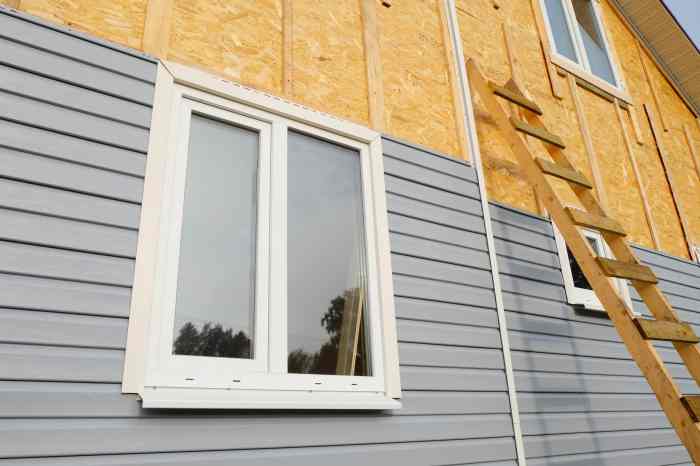
Sustainable siding offers a compelling blend of environmental responsibility and aesthetic appeal. Choosing eco-friendly materials doesn’t mean sacrificing style; in fact, many sustainable options boast unique visual characteristics that can enhance a home’s curb appeal and architectural character. The right choice depends on the desired aesthetic, budget, and regional climate.Sustainable siding materials present a diverse range of visual possibilities, allowing homeowners to express their individual style while contributing to a greener future.
From the rustic charm of reclaimed wood to the sleek modernity of fiber cement, the options are varied and visually rich. Understanding these aesthetic qualities is key to selecting the perfect siding for any project.
Architectural Styles and Sustainable Siding
The versatility of sustainable siding materials makes them suitable for a wide range of architectural styles. Reclaimed wood siding, for instance, complements rustic farmhouse designs, adding a sense of history and warmth. Its varied textures and natural color variations create a unique, lived-in look. Modern homes often utilize fiber cement siding, showcasing its clean lines and ability to mimic the appearance of other materials like stucco or painted wood, offering a sleek, contemporary aesthetic.
For homes with a more traditional design, bamboo siding can provide a sophisticated and elegant touch, with its natural grain and subtle coloring. The adaptability of these materials ensures they seamlessly integrate into diverse architectural contexts.
Visual Appeal and Versatility of Sustainable Siding Materials
The visual appeal of sustainable siding options varies significantly. Reclaimed wood offers a rich, textured surface with variations in color and grain, providing a rustic and charming aesthetic. Its natural imperfections add character and contribute to a unique look. Bamboo siding boasts a smooth, clean surface with a subtly varied grain pattern, creating a more refined and contemporary feel.
Fiber cement siding, on the other hand, offers exceptional versatility. It can be textured to mimic wood grain, or left smooth for a modern look, and can be painted virtually any color, offering unparalleled design flexibility. These varied textures and appearances cater to diverse tastes and architectural styles.
Color Options and Finishes
Sustainable siding materials offer a broad spectrum of color options and finishes. Reclaimed wood typically retains its natural tones, ranging from light browns and grays to deep reds and browns, depending on the wood type and weathering. Bamboo siding generally features natural light to medium brown hues, although it can be stained or treated to enhance its color.
Fiber cement siding is exceptionally versatile in this regard, as it can be painted in virtually any color, allowing homeowners to match their siding to their existing home design or create a completely new look. Various finishes are also available, including smooth, textured, and even options that mimic the look of stone or stucco.
Visual Representation of a House with Sustainable Siding
Imagine a two-story house. The ground floor features reclaimed wood siding, its rich brown tones accentuated by the varied grain patterns. The wood’s natural weathering adds character, creating a rustic, inviting feel. The second story is clad in smooth, light gray fiber cement siding, providing a modern contrast to the ground floor. The contrast in materials and colors creates visual interest and depth.
A small section of the house, perhaps near the entrance, could feature bamboo siding, showcasing its smooth, elegant texture and natural light brown hue. This blend of materials demonstrates the versatility and aesthetic potential of sustainable siding options. The overall effect is a visually stunning home that seamlessly integrates natural beauty with contemporary design.
Installation and Maintenance
Choosing sustainable siding offers long-term environmental benefits, but successful implementation hinges on proper installation and consistent maintenance. Understanding these processes is crucial for maximizing the lifespan and performance of your eco-friendly exterior. This section details installation procedures for two popular sustainable options and provides a comprehensive maintenance guide for one, addressing potential challenges and offering solutions along the way.
Installation Procedures for Sustainable Siding Materials
Two prominent sustainable siding materials are reclaimed wood and fiber cement. Their installation differs significantly, requiring specialized techniques and tools. Understanding these differences is paramount for achieving a durable and aesthetically pleasing result.
- Reclaimed Wood Siding Installation: This process involves careful preparation of the reclaimed wood planks, ensuring they are properly cleaned, treated for moisture resistance (if necessary), and sized for consistent installation. Installation often mirrors traditional wood siding techniques, utilizing nails or screws to attach the planks to a prepared wall sheathing. Proper spacing and overlapping are key to preventing water damage and ensuring structural integrity.
The use of stainless steel fasteners is recommended to avoid corrosion.
- Fiber Cement Siding Installation: Fiber cement siding, known for its durability and low maintenance, is typically installed using a similar approach to vinyl siding. This involves fastening pre-cut panels to a prepared wall surface using nails or screws. The panels are often interlocked for a seamless finish. Precise measurements and cutting are crucial, as fiber cement is less forgiving than wood.
Special tools may be needed for cutting and shaping the panels accurately. Proper flashing and sealing around windows and doors are essential for waterproofing.
Maintenance Guide for Fiber Cement Siding
Regular maintenance significantly extends the lifespan of fiber cement siding. A proactive approach minimizes the need for costly repairs and ensures the continued aesthetic appeal of your home. This simple, step-by-step guide will help you keep your fiber cement siding looking its best.
- Annual Inspection: Conduct a thorough visual inspection at least once a year, checking for cracks, chips, or loose panels. Pay close attention to areas prone to moisture damage, such as corners and around windows and doors. Early detection of problems allows for timely repairs, preventing larger, more expensive issues down the line.
- Cleaning: Clean your siding at least twice a year using a pressure washer set to a low pressure setting. Avoid using abrasive cleaners or harsh chemicals, which can damage the surface. A simple solution of water and mild detergent is usually sufficient. For stubborn stains, consider using a specialized siding cleaner, always following the manufacturer’s instructions.
- Caulk and Sealant Inspection: Regularly check caulking and sealant around windows, doors, and other areas where siding meets other building materials. Reapply sealant as needed to maintain a watertight barrier. This is especially critical in climates with significant temperature fluctuations or heavy rainfall. A small crack can lead to significant water damage if left unchecked.
- Repairing Damage: Minor chips or cracks can often be repaired using a patching compound specifically designed for fiber cement. Larger damage may require replacing individual panels. Always follow the manufacturer’s instructions for repair procedures. For extensive damage, consulting a professional siding contractor is advisable.
Challenges in Installing Sustainable Siding and Solutions
While sustainable siding offers numerous advantages, installation can present unique challenges. Addressing these proactively ensures a smooth and successful project.
- Weight and Handling: Some sustainable materials, like fiber cement, can be heavier than traditional vinyl or aluminum siding, requiring more physical effort during installation. Solutions include using appropriate lifting equipment and employing additional installers to manage the weight effectively. Proper planning and staging of materials is also crucial.
- Specialized Tools: Certain sustainable siding types necessitate specialized tools for cutting, fastening, and finishing. For example, fiber cement requires a wet saw to prevent dust and ensure clean cuts. Investing in the right tools upfront minimizes delays and ensures a professional-quality installation.
- Moisture Sensitivity: Reclaimed wood, while beautiful, can be susceptible to moisture damage if not properly treated and installed. Solutions involve using appropriate sealants and ensuring proper ventilation behind the siding to prevent moisture buildup. Properly preparing the substrate (the underlying wall structure) is also critical.
Tools and Equipment for Installation and Maintenance
The specific tools required vary depending on the siding material. Having the right equipment upfront significantly improves efficiency and safety.
- Installation: Measuring tapes, levels, saws (circular saw for wood, wet saw for fiber cement), drills, nail guns or impact drivers, safety glasses, work gloves, ladders, scaffolding (potentially). For reclaimed wood, additional tools might include chisels and planers for shaping.
- Maintenance: Pressure washer, mild detergent, brushes, caulking gun, patching compound (fiber cement specific), putty knife, scraper.
Ending Remarks
Ultimately, the shift towards sustainable siding isn’t just a trend; it’s a necessary step towards responsible building practices. By understanding the various options, their respective strengths and weaknesses, and the long-term implications of your choice, you can make a significant contribution to environmental sustainability. This guide provides the foundation for making informed decisions that benefit both your project and the planet.
Remember to factor in lifecycle costs, maintenance requirements, and aesthetic preferences when making your final selection – your sustainable siding choice can significantly impact your project’s overall success and environmental footprint.

